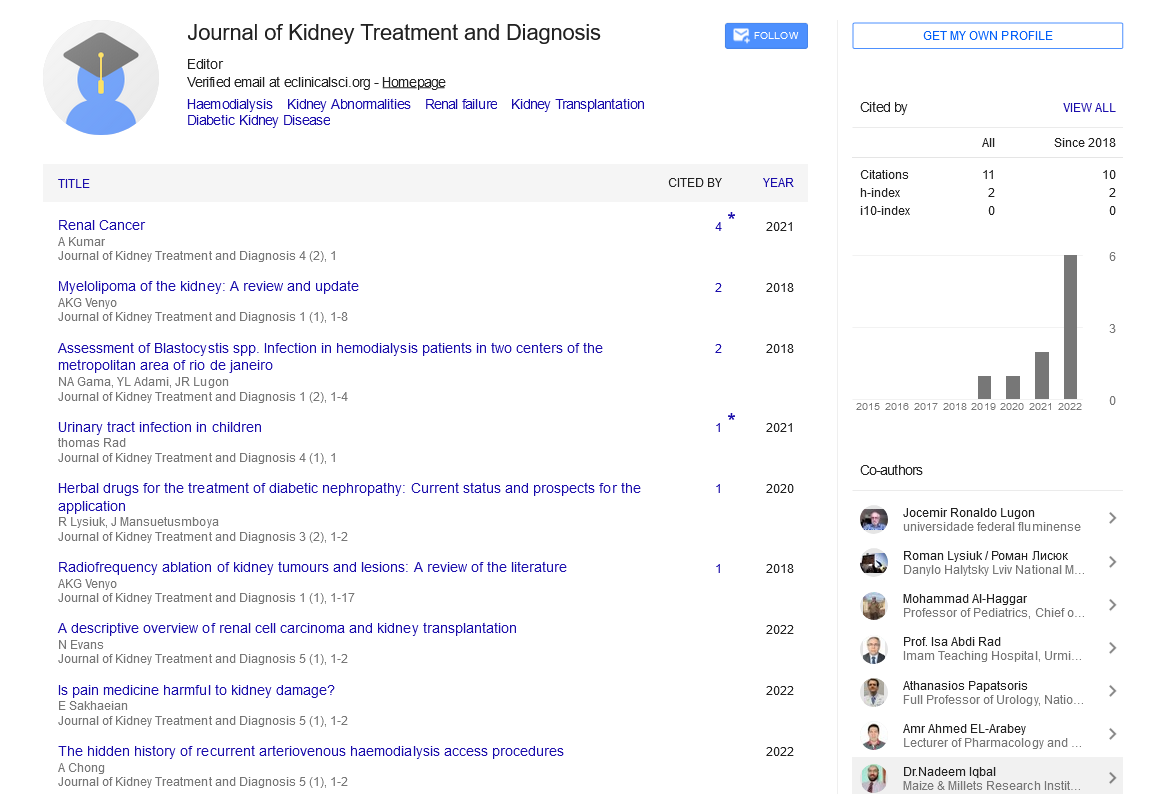Haemodialysis eefects for chronic kidney
Received: 18-Feb-2022, Manuscript No. PULJKTD-22-3945; Editor assigned: 21-Feb-2022, Pre QC No. PULJKTD-22-3945(PQ); Reviewed: 07-Mar-2022 QC No. PULJKTD-22-3945; Revised: 11-Mar-2022, Manuscript No. PULJKTD-22-3945(R); Published: 18-Mar-2022
Citation: Gharipour M. Haemodialysis effects for chronic kidney. J Kidney Treat Diagn. 2022;5(1):1
This open-access article is distributed under the terms of the Creative Commons Attribution Non-Commercial License (CC BY-NC) (http://creativecommons.org/licenses/by-nc/4.0/), which permits reuse, distribution and reproduction of the article, provided that the original work is properly cited and the reuse is restricted to noncommercial purposes. For commercial reuse, contact reprints@pulsus.com
Introduction
Healthy kidneys clean your blood and remove extra fluid in the kind of water. They also create substances that keep your body healthy. Dialysis replaces a number of these functions once your kidneys no longer work.
There are unit 2 different types of chemical analysis-dialysis and serosa chemical analysis. You would like dialysis if your kidneys now not take away enough wastes and fluid from your blood to stay healthy. This typically happens once you have only ten to 15 % of your kidney performance left. You will have symptoms like nausea, vomiting, swelling, and fatigue.
Description
However, even if you don't have these symptoms yet, you'll still have a high level of wastes in your blood that may be cyanogenic to your body. Your doctor is that the best person to inform you once you ought to start the chemical analysis. Dialysis access, or vascular access, maybe thanks to reaching the blood for hemodialysis. The access permits blood to travel through soft tubes to the dialysis machine wherever it's cleansed as it passes through a special filter, known as a dialysis machine.
Associate in nursing access is placed by minor surgery. As a dialysis patient, your access is one of the following: A fistula, access created by the change of integrity Associate in Nursing artery and vein in your arm. A graft, access is created by employing a piece of soppy tube to affix Associate in Nursing artery and vein in your arm.
A catheter, a soft tube that's placed in a very giant vein, usually in your neck. If your access may be a fistula or graft, your nurse or technician can place 2 needles into the access at the beginning of every treatment. These needles area units are connected to soft tubes that go to the dialysis machine. Your blood goes to the machine through one of the tubes, gets cleansed within the dialysis machine, and returns to you through the opposite tube. If your access may be tubing, it is often connected to the dialysis tubes while not the use of needles. A fistula ought to be considered the primary choice for your access as a result of it usually lasts longer and has fewer issues like infections and action. However, some patients might not be able to receive a fistula as a result of their blood vessels isn’t strong enough. A graft is taken into account as the second alternative for access.
Conclusion
Catheters area units are usually used as brief access, however generally they're permanent. Sometimes, it should be doable to change to a fistula from another sort of access. If you are doing not have a fistula, raise your chemical analysis care team if a switch would be possible for you. Sometimes, even once you area unit very careful, your access could clot or become infected. If an associate in nursing infection occurs, your doctor can order antibiotics for you. If your access develops a clot, you will move to the hospital for treatment. Removing the clot will usually be done on an associate in nursing patient basis, and you'll not need to keep it long.





